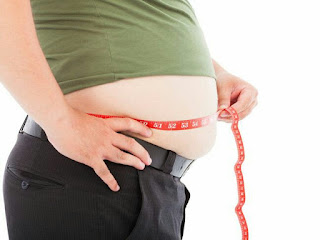Obesity (over weight)
OBESITY
Obesity is mostly attributed to poor lifestyle choices, such as eating processed foods high in fat, oversized food portions, overeating, excessive drinking, lack of physical activity, lack of sleep, and other similar habits. Genetic factors and hormonal problems also tend to increase the risk of developing obesity.
Obesity is a great concern not merely because of the excess weight, but also because it makes you susceptible to a number of serious health problems such as Type 2 diabetes, high blood pressure, heart disease, and others.
ASSESSMENT
1. Body weight
An adult weighting 10 percent more than thestandard weight is overweight and 20 percent more is obese.
2. Body mass index Obesity is expressed in terms of BMI-Body
Mass Index,
BMI
Normal - 20 – 24.9
Overweight - 25 – 29.9Obese - 30 – 39
3. Waist circumference
It is the most practical tool to evaluatea patients’ abdominal fat.
High risk waist circumference
Men > 40 in (>102 cm)
Women > 35 in (>88 cm)
4. Waist to Hip ratio (WHR)
This is the most frequently used measure of adiposity. It isalso called abdominal / gluteal ratio.
The normal ratio Waist = 0.7
A WHR of 1.0 or greater in men
and 0.8 or greater in women.
is indicative of android obesity and increased risk for obesity related
diseases.
OBESITY - GRADES
I, 2 and 3
Grading can be done based on BMI
1) Normal - 20 - 25
2) Grade I obese - 25-29.9
3) Grade II obese - 30-40
4) Grade III obese - > 40
DIETARY MODIFICATION
restricted carbohydrate, restricted fat but with
normal protein, vitamins and minerals (except sodium) liberal intakeof fluid and high in fibre is given.
Energy
20 Kcal /kg I will for
sedentary worker
and 25 Kcal for moderately active worker.
Proteins
0.8 to 1g of protein / kg body weight
Carbohydrates (CHO)
High carbohydrate content foods like potatoes
and rice are restricted.
Sugar which gives empty calories should be
totally avoided. Fruits rich in carbohydrate like banana should be
avoided. To produce a feeling of satiety and regular bowel
movements, bulk-producing carbohydrates like green leafy
vegetables and fruits are given.
Fat
Low fat or no fat should be given.
Foods rich in fat like nuts and oil seeds are avoided.
Skim milk
should be given.
Vitamins
With prolonged restriction of fats, there is likely to be a
restriction of fat soluble vitamins A and D which may be
supplemented.
Minerals
Sodium intake is to be restricted as excess sodium
predisposes to retention of fluid.
Fluid
If salt is restricted then fluids can be taken liberally as extra
fluids are excreted by the healthy kidneys. A glass of water taken
before meals may help to cut down the intake of food.
High fibre
High fibre, low calorie food like green leafy vegetables,
fruits, vegetable salads, whole grain cereals and pulses can be
included in the diet. The advantages of using high fibre foods are.
• They are low in calorie.
• Foods like greens provide vitamins and minerals.
• High fibre diets give satiety.
• Help in regulating bowel movements.
• Reduce blood cholesterol.


Comments
Post a Comment